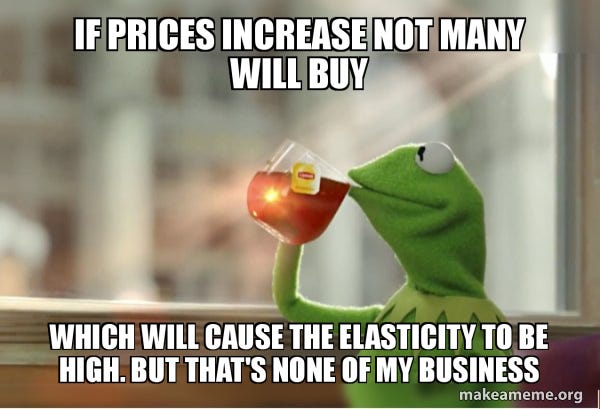Does brand really matter?
Three practical examples of how brand equity can make a difference.
During the time I worked at Bolt, our motto was: “We prioritize substance over form.”
What this meant was that the tangible value proposition was always put first.
For a commodity marketplace, that generally holds true. If you’re out on the street catching a cab, it doesn’t really matter whether it’s Uber or Bolt that picks you up. What matters is how fast the car arrives and how much you’ll pay.
In this light, the brand was always treated more like an idea rather than a tangible asset. It was something the “creatives from the brand department” were working on.
This year, however, I was looped in two rebranding initiatives. I was partially involved in Bolt’s most recent rebranding in Estonia and am now actively working on the rebranding of Bir ecosystem and Umico in Azerbaijan.
This has led me to ponder: why care about brands at all? In today’s era of saturated markets and limited attention spans, differentiation seems to matter less and less. As Marty Neumeier puts it, “Brand power has shifted away from companies to consumers.”
Are we living in a time where the brand, as a concept, is becoming obsolete?
Below, I want to challenge myself by listing three practical cases where branding made a tangible difference.
Today’s article
A short foreword on brand. How a simple idea got diluted with theory.
Three tangible brand effects. Lower acquisition costs, faster time to hire, lower price sensitivity.
📖 A short foreword on the brand
The word “brand” originally derives from the Old Icelandic word “Brandr”, which literally means “burn by fire.” In ancient times, livestock was marked with hot irons for differentiation purposes.
In essence, a brand is an idea that differentiates a company from the rest.
However, over the past century, this simple notion was diluted with fancy concepts about positioning, brand equity and awareness. Some authors even went as far as claiming that brand is about everything that happens in the org. Product, organization, sales and visual symbols are all parts of the brand.
On top of it, the rules of the game have changed. There are so many options in the cluttered marketplace, that standalone ideas don’t really matter. What matters is that the price and value ratios are right.
This has led many pragmatic managers to believe that brand is mostly about “cosmetics”. It is not so.
Three tangible brand effects
💸 Lower acquisition costs
Byron Sharp’s research, outlined in his seminal book How Brands Grow, suggests that the human mind can associate a company with only one distinct meaning.
When two businesses are merged under a single brand, brand dilution often occurs.
Six years ago, Umico launched as a loyalty app, allowing users to collect and redeem bonuses while accessing discounts. Later, an e-commerce marketplace was integrated into the platform.
A few weeks ago, I conducted interviews with SMB and micro-merchants.
Of the 15 merchants interviewed, approximately 30% said they do not accept bonuses as a payment method when asked about Umico.
For the conservative majority, Umico is still perceived as “just a loyalty app.”
This perception has tangible consequences: acquiring these merchants will be more costly, requiring not just sales efforts but also investment in education. According to our internal estimates, such merchants are three times more expensive to onboard onto the platform despite the clear value communications.
On top of that, the word-of-mouth virality effect will be weaker, making organic growth more difficult.
This is one of the key reasons why we’re actively working on a rebranding for the service.
⚡ Faster time to hire
About a year ago, Bolt began actively promoting the “cities without cars” message. A few months later, I noticed an interesting effect.
As the campaign gained traction, more candidates in interviews mentioned how this message resonated with them.
What’s even more intriguing is that the profile of these candidates began to shift—they increasingly had backgrounds in mobility and urban planning.
Having interviewed approximately 300 people weekly over the past four years, the difference before and after the campaign was striking.
Most importantly, despite our strict interview process and low conversion rates, we successfully closed a significantly higher number of candidates after the campaign’s launch (though I can’t disclose exact figures).
🏷️ Lower price sensitivity
According to the studies dating back to 1990s, brand equity can change customer’s price elasticity.
A brand can command a ~13-20% higher premium in a commodity market over the generic manufacturer (a classic case of “Tide” detergent vs. generics). Emotional brand attachment in general reduces the “price comparison” intent.
You don’t need to go far:
AWS is on general 20-30% more expensive than DigitalOcean or Vultr;
Jira commands a 8$ / per user month while many cheaper or free alternatives exist (Trello, Clickup, Monday.com e.t.c.);
Microsoft Office 365 charges at minimum 13$/month per customer and scales, despite free alternatives such as Google docs;
Adobe Premiere costs 23$/month while DaVinci Resolve can be accessed for free.
📌 TL;DR
Brand simply means attaching an idea to your company—a singular, simple idea that creates an association with the user.
Theoretical musings on brand, stretching from positioning to brand equity, have diluted this simple concept. In commodity marketplaces, there is a strong managerial bias to view brand purely in terms of “cosmetics.”
Over the course of my career, I’ve observed three tangible effects that a strong brand can have:
Cheaper acquisition costs due to clearer differentiation. Diluted or generic brand messages can increase this cost by at least 3×.
Faster time to hire. With the right messaging, you’ll attract more relevant candidates more quickly.
Reduced price elasticity for branded items, even in commodity marketplaces. Companies with stronger brand equity command a premium of approximately 13–20%.








